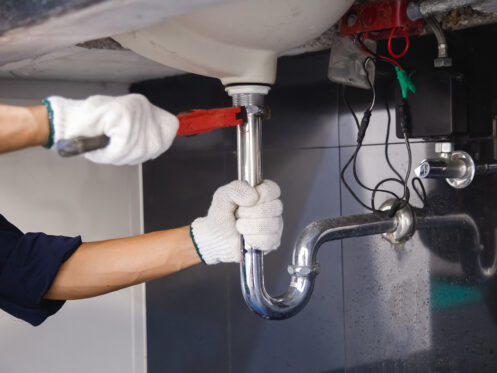Yes, your plumbing system needs regular maintenance. Most experts agree that annual inspections and upkeep are sufficient. While you can contribute by monitoring for water leaks and clogged drains, it’s advisable to entrust most maintenance tasks to professionals.
Inspecting for Water Leaks
A key part of plumbing maintenance involves inspecting the home for water leaks. To do this, a plumber will walk around the home, looking for water stains on floors, ceilings and walls. Many plumbers use water meter tests and leak detectors to find hidden pipe leaks. Comparing current water bills to previous year’s can help reveal leaks as well.
Finding and fixing leaks is paramount for maintaining comfort in your home. Leaks that go unaddressed can lead to mold and mildew growth. If water gets into the foundation, it’ll eventually cause structural flaws like cracks in the walls and floors.
Checking Water Pressure
Water pressure that’s too high worsens the likelihood of pipe leaks. When the pressure is too low, this can compromise your ability to do normal tasks like taking a shower, washing dishes and doing laundry. To check the water pressure in your home, a plumber will connect a pressure gauge to a fixture or faucet, turn on the water and then switch off the water meter. Good water pressure readings are between 45 and 55 psi. Anything lower than 45 psi can lead to trickling faucets.
If your home water pressure isn’t in the ideal range, plumbers have several solutions they can provide. They can adjust the pressure-reducing valve, install a water pressure booster or even install a pump. To achieve minor pressure increases, a centrifugal pump is usually sufficient; to achieve significant increases, it may be necessary to use a positive displacement pump.
Clearing Clogged Drains
Clogged drains are extremely detrimental to your plumbing. They wear out seals and caulking, leading to pipe leaks. This is particularly a problem for those connected to sinks and tubs. Debris and residue buildup from clogged drains can eat away at the pipe walls, triggering corrosion and burst pipes. Clogged drains also increase the risk of backups and flooding. If you’re not there to spot the overflow, you may come home to serious water damage.
Plumbers pick from a number of drain-clearing methods when dealing with clogged drains. Some use drain augers or hydro jetters to clear obstructions. Some insert a drain rod to loosen grime and clear away any buildup that is stuck inside the pipes. In some situations, a plumber may use a video camera inspection to determine the severity of a clog and choose a cleaning method.
Insulating Exposed Pipes
Exposed plumbing presents major challenges for homes located in climates where there are freezing temperatures. When pipes freeze, the water in them can freeze as well. And when it does, it expands and puts immense pressure on the pipes. The pressure can build up so high that it cracks the pipes, resulting in water leaks. Depending on which pipe it is, it can even lead to a loss of water access throughout the whole home. The easiest way to keep this from happening is to have a plumber insulate the pipes during regular maintenance.
Flushing the Water Heater
Flushing the water heater is another important component of routine maintenance. This improves its performance because it removes sediment buildup in the tank. The insulating properties of sediment allow it to retain heat and lower water pressure. Even tankless systems require flushing once a year to perform at their best. Boosting efficiency leads to less energy use and lower water bills.
Testing Bacteria in Septic Tanks
A septic system is more than just a network of pipes and drains. The microbial system inside is responsible for the active maintenance of your septic system. It consists of yeasts, bacteria and enzymes. Its job is to break down the materials that have accumulated at the base of the tank and initiate the breakdown process. When the septic system doesn’t have the right balance of microbial activity, it can clog and backup.
During maintenance, your plumber may use a dye test to test the bacteria in the septic tank. Despite the little data it yields, this test does advise whether more testing is necessary. Plumbers can treat septic tanks with enzymes or use natural microorganisms to restore bacterial equilibrium. Septic enzyme therapies promote the development of bacteria, whereas natural microorganisms swiftly restore the bacterial balance.
No matter what kind of plumbing repair you need, Smooth Plumbing is ready to help. Among the many services we provide to residents in Alexandria, VA, are gas line installations, sewage services, water pressure testing and leak detection. To schedule plumbing maintenance for your home, contact us now.

